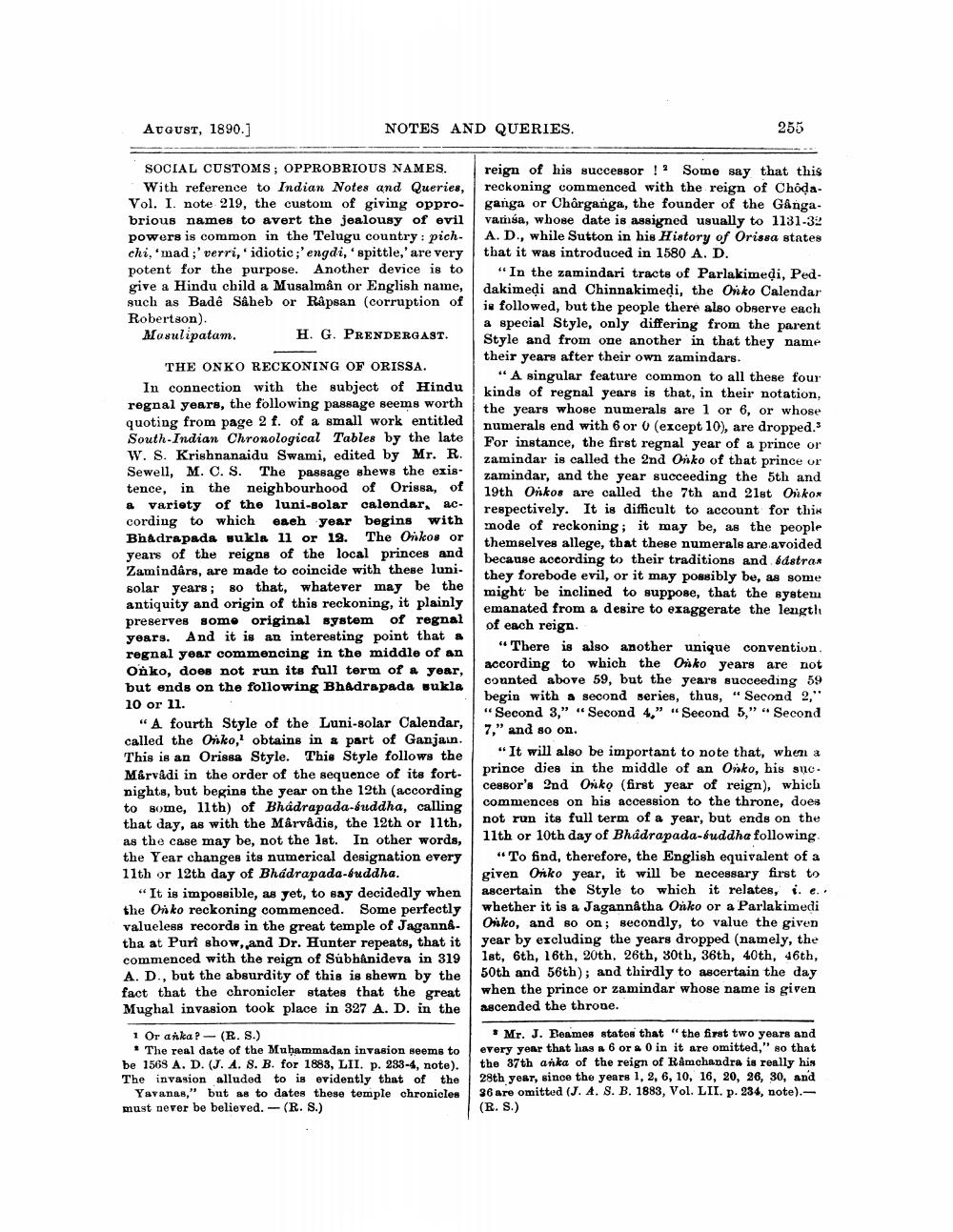________________
AUGUST, 1890.]
NOTES AND QUERIES.
255
SOCIAL CUSTOMS; OPPROBRIOUS NAMES. With reference to Indian Notes and Queries, Vol. I. note 219, the custom of giving opprobrious names to avert the jealousy of evil powers is common in the Telugu country: pich. chi, mad;' verri, 'idiotic;'engdi, spittle,' are very potent for the purpose. Another device is to give a Hindu child a Musalman or English name, such as Badê Saheb or Rápsan (corruption of Robertson).
Mosulipatam. H. G. PRENDERGAST.
THE ONKO RECKONING OF ORISSA. In connection with the subject of Hindu regnal years, the following passage seems worth quoting from page 2 f. of a small work entitled South-Indian Chronological Tables by the late W. S. Krishnanaidu Swami, edited by Mr. R. Sewell, M. C. S. The passage shews the existence, in the neighbourhood of Orissa, of a variety of the luni-solar calendar, according to which eaeh year begins with Bhadrapada sukla 11 or 12. The Onkos or years of the reigns of the local princes and Zamindars, are made to coincide with these luni. solar years; BO that, whatever may be the antiquity and origin of this reckoning, it plainly preserves some original system of regnal years. And it is an interesting point that a regnal year commencing in the middle of an Onko, does not run its full term of a year, but ends on the following Bhadrapada sukla 10 or 11.
"A fourth Style of the Luni-solar Calendar, called the Onko, obtains in a part of Ganjain. This is an Orissa Style. This Style follows the Mérvadi in the order of the sequence of its fortnights, but begins the year on the 12th (according to some, 11th) of Bhadrapada-buddha, calling that day, as with the Marvadis, the 12th or 11th, as the case may be, not the let. In other words, the Year changes its numerical designation every 11th or 12th day of Bhadrapada-buddha.
It is impossible yet to y decidedly when the Onko reckoning commenced. Some perfectly valueless records in the great temple of Jaganna. tha at Puri show, and Dr. Hunter repeats, that it commenced with the reign of Subhanideva in 319 A. D., but the absurdity of this is shewn by the fact that the chronicler states that the great Mughal invasion took place in 327 A. D. in the
reign of his successor !? Some say that this reckoning commenced with the reign of Chôdaganga or Chårganga, the founder of the Ganga. vamsa, whose date is assigned usually to 1131-32 A.D., while Sutton in his History of Orissa states that it was introduced in 1580 A. D.
"In the zamindari tracts of Parlakimedi, Ped dakimedi and Chinnakimedi, the Onko Calendar is followed, but the people there also observe each a special Style, only differing from the parent Style and from one another in that they name their years after their own zamindars.
"A singular feature common to all these four kinds of regnal years is that, in their notation, the years whose numerals are 1 or 6, or whose numerals end with 6 or 0 (except 10), are dropped. For instance, the first regnal year of a prince or zamindar is called the 2nd Onko of that prince or zamindar, and the year succeeding the 5th and 19th Onkos are called the 7th and 21st Onkox respectively. It is difficult to account for this mode of reckoning; it may be, as the people themselves allege, that these numerals are avoided because according to their traditions and 6dstrar they forebode evil, or it may possibly be, as some might be inclined to suppose, that the system emanated from a desire to exaggerate the length of each reign.
"There is also another unique convention. according to which the Onko years are not counted above 59, but the years suoceeding 59 begin with a second series, thus, " Second 2," "Second 3," " Second 4." " Second 5," " Second 7," and so on.
" It will also be important to note that, when a prince dies in the middle of an Onko, his suc. cessor's 2nd Onko (first year of reign), which commences on his accession to the throne, does not run its full term of a year, but ends on the 11th or 10th day of Bhadrapada-fuddha following
"To find, therefore, the English equivalent of a given Onko year, it will be necessary first to ascertain the Style to which it relates, i.e.. whether it is a Jagannatha Onko or a Parlakimedi Oniko, and so on; secondly, to value the given year by excluding the years dropped (namely, the lst, 6th, 16th, 20th, 26th, 30th, 36th, 40th, 46th, 50th and 56th); and thirdly to ascertain the day when the prince or zamindar whose name is given ascended the throne.
1 Or anka? - (R. S.)
. The real date of the Muhammadan invasion seems to be 1568 A. D. (J. A. 8. B. for 1883, LII. p. 233-4, note). The invasion alluded to is evidently that of the
Yavanas," but as to dates these temple chronicles must never be believed. -(R. S.)
Mr. J. Beamer states that "the first two years and every year that has a 6 or a 0 in it are omitted," so that the 37th anka of the reign of Ramchandra is really his 28th year, since the years 1, 2, 6, 10, 16, 20, 26, 30, and 36 are omitted (J. A. S. B. 1883, VOL. LIL. P. 234, note). - (R. S.)




